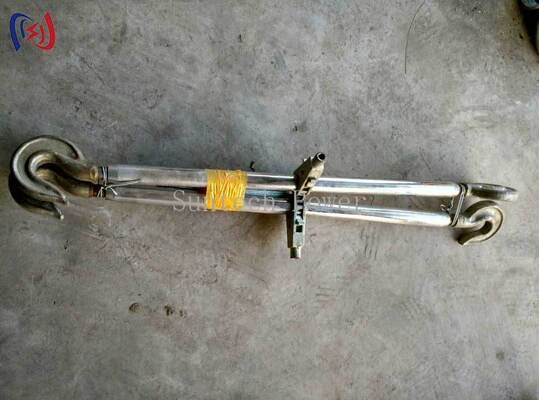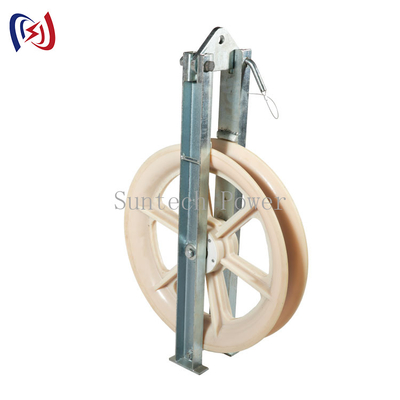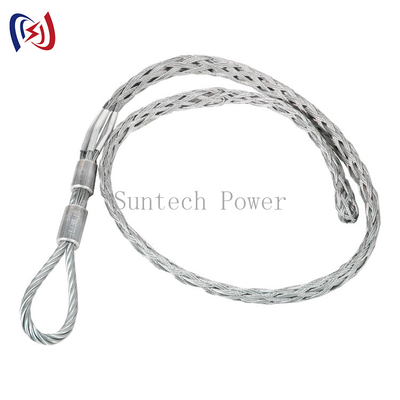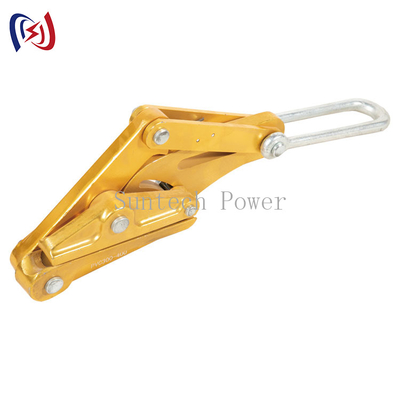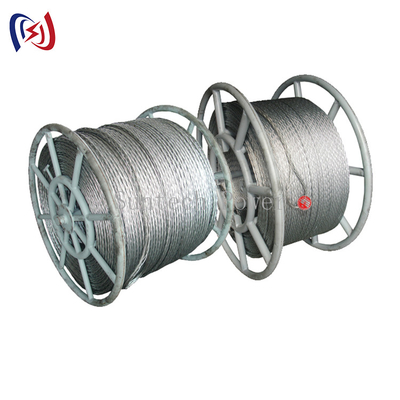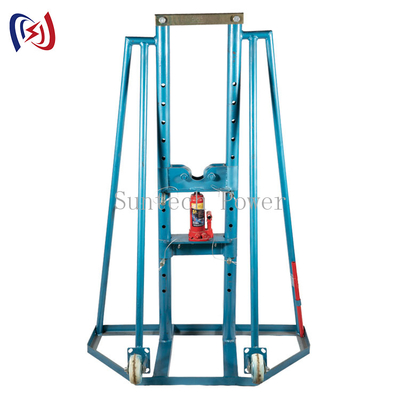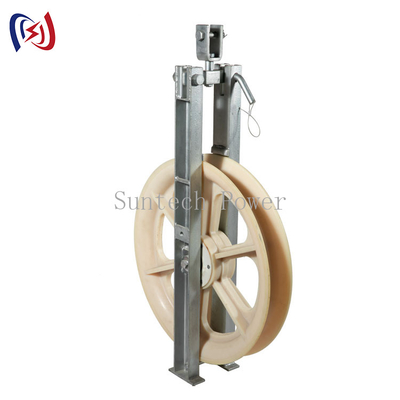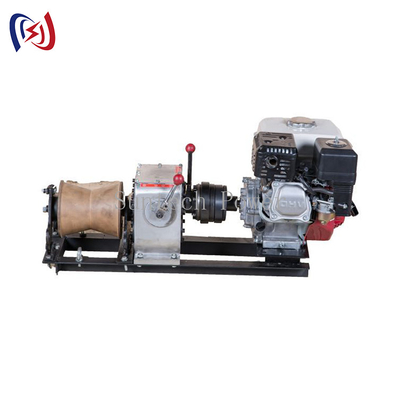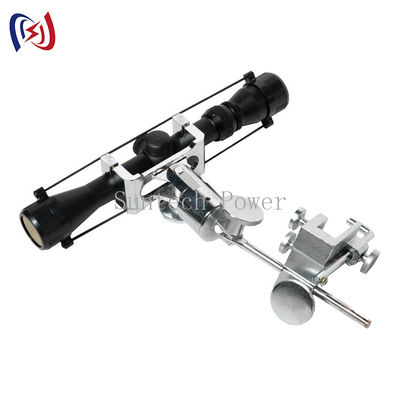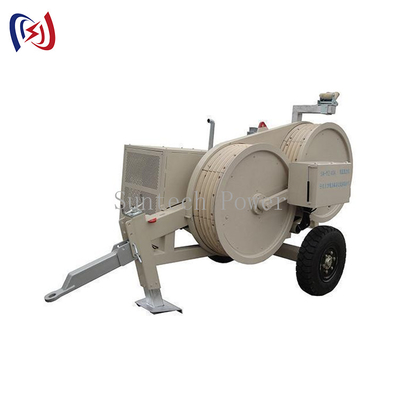ในสภาพแวดล้อมที่มีความเสี่ยงสูงของการก่อสร้างและบำรุงรักษาสายไฟฟ้าเหนือศีรษะ ความปลอดภัยและความแม่นยำเป็นสิ่งที่ไม่สามารถต่อรองได้ แม้ว่าจุดสนใจหลักมักจะอยู่ที่การติดตั้งตัวนำไฟฟ้า แต่ภัยคุกคามที่มองไม่เห็นและมีศักยภาพยังคงอยู่: อันตรายจากแรงดันไฟฟ้าเหนี่ยวนำและไฟฟ้าสถิต บล็อกสายดิน ซึ่งมักเป็นฮีโร่ที่ไม่ได้รับการยกย่องในสถานที่ทำงาน เป็นอุปกรณ์ความปลอดภัยที่สำคัญซึ่งออกแบบมาโดยเฉพาะเพื่อกำจัดอันตรายที่ซ่อนอยู่นี้ ปกป้องทั้งบุคลากรและอุปกรณ์ระหว่างการปฏิบัติงานดึงสาย
สำหรับบริษัทสาธารณูปโภค ผู้รับเหมา และช่างไฟฟ้าที่ทำงานในโครงการส่งและจำหน่ายทั่วเอเชียกลาง ตะวันออกกลาง แอฟริกา อเมริกาใต้ และเอเชียตะวันออกเฉียงใต้ ซึ่งโครงการมักจะครอบคลุมระยะทางที่กว้างใหญ่และภูมิประเทศที่หลากหลาย การรวมโปรโตคอลความปลอดภัยที่แข็งแกร่งถือเป็นสิ่งสำคัญยิ่ง คู่มือนี้ให้ภาพรวมที่ครอบคลุมและเป็นกลางของบล็อกสายดิน อธิบายถึงหน้าที่สำคัญ ประโยชน์หลัก และปัจจัยสำคัญที่ต้องพิจารณาในระหว่างการจัดซื้อ
หากต้องการสำรวจบล็อกสายดินที่ทนทานและเชื่อถือได้เต็มรูปแบบ ซึ่งออกแบบมาสำหรับสภาวะที่ต้องการมากที่สุด เราขอเชิญคุณเยี่ยมชมหน้าแรกของผลิตภัณฑ์ของเราเพื่อดูข้อมูลจำเพาะและตัวเลือกโดยละเอียด
การทำความเข้าใจภัยคุกคามที่มองไม่เห็น: แรงดันไฟฟ้าเหนี่ยวนำและประจุไฟฟ้าสถิต
ในระหว่างการดึงสายไฟ จะมีอันตรายทางไฟฟ้าหลักสองประการ แม้แต่ในสายไฟที่ไม่มีกระแสไฟฟ้า:
-
แรงดันไฟฟ้าเหนี่ยวนำ: เมื่อตัวนำใหม่ถูกขึงขนานกับสายไฟที่มีกระแสไฟฟ้าอยู่ สนามแม่เหล็กไฟฟ้าจากสายไฟที่มีกระแสไฟฟ้าสามารถ "เหนี่ยวนำ" แรงดันไฟฟ้าที่เป็นอันตรายให้กับตัวนำใหม่ที่ไม่มีกระแสไฟฟ้า แรงดันไฟฟ้านี้อาจรุนแรงพอที่จะทำให้เกิดไฟฟ้าช็อตได้
-
ไฟฟ้าสถิต: เมื่อตัวนำถูกดึงผ่านอากาศ โดยเฉพาะอย่างยิ่งในสภาพอากาศแห้ง ลมแรง หรือมีฝุ่น (ซึ่งเป็นเรื่องปกติในหลายภูมิภาคเป้าหมาย) แรงเสียดทานอาจทำให้เกิดการสะสมประจุไฟฟ้าสถิตจำนวนมากบนตัวนำ ประจุนี้สามารถโค้งงอลงดินหรือไปยังบุคคล ทำให้เกิดการกระแทกที่เจ็บปวดและอาจเป็นอันตรายได้
บล็อกสายดินเป็นโซลูชันทางวิศวกรรมสำหรับปัญหาเหล่านี้ โดยให้เส้นทางที่ปลอดภัยและควบคุมได้สำหรับไฟฟ้าที่ไม่ต้องการนี้เพื่อกระจายไปในดินอย่างไม่เป็นอันตราย
วิธีการทำงานของบล็อกสายดิน: หลักการของการกระจายตัวอย่างปลอดภัย
บล็อกสายดินไม่ใช่แคลมป์ธรรมดา เป็นอุปกรณ์ที่สร้างขึ้นโดยมีวัตถุประสงค์ซึ่งรวมเข้ากับระบบการดึงสายไฟ การทำงานเป็นไปอย่างเป็นระบบและมีความสำคัญ:
-
การรวม: บล็อกสายดินถูกติดตั้งโดยตรงบนตัวนำในระหว่างกระบวนการดึงสายไฟ โดยทั่วไปจะวางระหว่างตัวปรับความตึงและตัวดึง มักจะติดอยู่กับจุดยึดอยู่กับที่หรือรถเข็นเคลื่อนที่บนตัวปรับความตึง
-
การเชื่อมต่อ: สายดินแบบยืดหยุ่นสำหรับงานหนักถูกยึดเข้ากับขั้วต่อเฉพาะบนบล็อกอย่างแน่นหนา
-
เส้นทางสู่โลก: ปลายอีกด้านหนึ่งของสายเคเบิลนี้เชื่อมต่อกับแท่งสายดินที่ติดตั้งอย่างถูกต้องซึ่งถูกขับลึกลงไปในพื้นดิน สร้างเส้นทางที่มีความต้านทานต่ำลงสู่พื้นดิน
-
การป้องกันอย่างต่อเนื่อง: เมื่อตัวนำเคลื่อนที่ผ่านบล็อกในระหว่างกระบวนการดึงสายไฟ บล็อกจะรักษาการสัมผัสทางไฟฟ้าอย่างต่อเนื่อง แรงดันไฟฟ้าเหนี่ยวนำหรือประจุไฟฟ้าสถิตที่สะสมบนตัวนำจะถูกเปลี่ยนเส้นทางทันทีผ่านบล็อกและลงสายเคเบิลลงสู่พื้นดิน ทำให้เป็นกลางซึ่งเป็นอันตรายในแบบเรียลไทม์
ทำหน้าที่เป็นวาล์วนิรภัยสำหรับไฟฟ้า ทำให้มั่นใจได้ว่าตัวนำยังคงมีศักย์ไฟฟ้าเป็นศูนย์ (0 โวลต์) ตลอดการทำงาน
การใช้งานหลักในภาคสนาม
บล็อกสายดินเป็นสิ่งจำเป็นสำหรับ:
-
การก่อสร้างสายส่งใหม่: เมื่อดึงตัวนำใกล้กับสายไฟที่มีกระแสไฟฟ้าอยู่
-
โครงการปรับปรุงสายไฟใหม่: การเปลี่ยนตัวนำเก่าในทางเดินที่มีกระแสไฟฟ้า
-
การอัปเกรดสายจำหน่าย: การทำงานในพื้นที่แออัดที่มีวงจรที่มีอยู่หลายวงจร
-
การบำรุงรักษาและซ่อมแซม: ทุกครั้งที่มีการจัดการตัวนำในสภาพแวดล้อมที่มีอันตรายจากไฟฟ้า
การใช้งานเป็นแนวทางปฏิบัติที่ดีที่สุดขั้นพื้นฐานและมักเป็นข้อกำหนดบังคับภายใต้กฎความปลอดภัยของสาธารณูปโภค (เช่น มาตรฐาน OSHA, IEC)
คู่มือสำหรับผู้ซื้อ: ปัจจัยสำคัญในการเลือกบล็อกสายดินที่เหมาะสม
การเลือกบล็อกสายดินที่ไม่เพียงพออาจสร้างความรู้สึกปลอดภัยที่ผิดพลาด สำหรับผู้จัดการด้านความปลอดภัยและหัวหน้าช่างไฟฟ้า นี่คือปัจจัยทางเทคนิคและการปฏิบัติที่จำเป็นที่ต้องพิจารณา
1. พิกัดกระแสไฟฟ้า (พิกัด kA)
นี่คือข้อกำหนดที่สำคัญที่สุด กำหนดปริมาณกระแสไฟฟ้าลัดวงจรที่บล็อกสามารถจัดการได้อย่างปลอดภัยเป็นระยะเวลาหนึ่ง (เช่น 20 kA เป็นเวลา 1 วินาที) พิกัดต้องเพียงพอสำหรับแรงดันไฟฟ้าเหนี่ยวนำและกระแสไฟฟ้าลัดวงจรที่อาจเกิดขึ้นในสภาพแวดล้อมการทำงานเฉพาะของคุณ ควรใช้พิกัดที่สูงกว่าเสมอ
2. ความเข้ากันได้ของตัวนำและการออกแบบขากรรไกร
-
ช่วงเส้นผ่านศูนย์กลาง: บล็อกต้องได้รับการออกแบบสำหรับเส้นผ่านศูนย์กลางเฉพาะของตัวนำของคุณ (เช่น ACSR, AAAC) การใช้บล็อกบนตัวนำที่มีขนาดเล็กเกินไปจะส่งผลให้การสัมผัสทางไฟฟ้าไม่ดี
-
วัสดุขากรรไกร: โดยทั่วไปขากรรไกรทำจากทองแดงหรือโลหะผสมทองแดงเบริลเลียม ซึ่งให้การนำไฟฟ้าที่ดีเยี่ยมและทนทานต่อความเสียหายจากการอาร์ค
-
กลไกแรงดัน: ขากรรไกรต้องให้แรงดันที่มั่นคงและสม่ำเสมอต่อตัวนำผ่านสปริงที่แข็งแรงหรือกลไกสลักเกลียวแบบเกลียว เพื่อให้มั่นใจถึงการเชื่อมต่อที่มีความต้านทานต่ำ แม้ว่าตัวนำจะสั่นสะเทือนหรือเคลื่อนที่
3. สายดินและการเชื่อมต่อ
-
ขนาดสายเคเบิล: บล็อกต้องมีขั้วต่อที่เข้ากันได้กับสายดินแบบยืดหยุ่นที่มีเส้นผ่านศูนย์กลางขนาดใหญ่ (เช่น 4/0 AWG หรือใหญ่กว่า) สายเคเบิลเป็นส่วนสำคัญของระบบและต้องมีพิกัดกระแสไฟฟ้าสูงของตัวเอง
-
การเชื่อมต่อขั้วต่อ: ขั้วต่อต้องมีจุดเชื่อมต่อที่ปลอดภัยและมีความต้านทานต่ำสำหรับขั้วต่อสายเคเบิล ซึ่งมักจะผ่านสลักเกลียวทองเหลืองหรือสแตนเลสเพื่อป้องกันการกัดกร่อน
4. การก่อสร้างและความทนทาน
-
ความแข็งแรงของเฟรม: ตัวเครื่องหลักต้องสร้างจากวัสดุที่มีความแข็งแรงสูงและไม่กัดกร่อน เช่น อะลูมิเนียมหรือสแตนเลส เพื่อทนทานต่อความเข้มงวดทางกายภาพของสถานที่ทำงาน
-
ความต้านทานการกัดกร่อน: เมื่อพิจารณาถึงสภาพแวดล้อมกลางแจ้ง ซึ่งมักจะรุนแรง วัสดุและการตกแต่งต้องทนทานต่อการกัดกร่อนจากฝน ละอองเกลือ (พื้นที่ชายฝั่ง) และความชื้น
-
ความต้านทาน UV: ส่วนประกอบไม่ควรเสื่อมสภาพเมื่อสัมผัสกับแสงแดดเป็นเวลานาน
5. ใช้งานง่ายและคุณสมบัติด้านความปลอดภัย
-
การใช้งานด้วยมือเดียว: กลไกที่ช่วยให้เปิดและปิดได้ง่ายด้วยมือเดียว (ขณะสวมถุงมือ) ช่วยเพิ่มประสิทธิภาพและความปลอดภัย
-
การล็อคแบบบวก: กลไกการล็อคที่ชัดเจนและปลอดภัยช่วยป้องกันไม่ให้บล็อกเปิดโดยไม่ได้ตั้งใจระหว่างการทำงาน
-
การมองเห็น: สีที่มองเห็นได้ชัดเจน (เช่น สีเหลืองเพื่อความปลอดภัย) ช่วยให้มั่นใจได้ว่าจะไม่ลืมอุปกรณ์บนสาย
การลงทุนในบล็อกสายดินคุณภาพสูงที่ได้รับการจัดอันดับอย่างถูกต้องเป็นการลงทุนโดยตรงในความปลอดภัยของพนักงานและความต่อเนื่องในการดำเนินงาน สำหรับการเลือกบล็อกที่ตรงตามเกณฑ์ที่เข้มงวดเหล่านี้ มีข้อมูลโดยละเอียดในเว็บไซต์หลักของเรา
แนวทางปฏิบัติที่ดีที่สุดในการดำเนินงานและความปลอดภัย
-
การตรวจสอบ: ตรวจสอบบล็อก สายเคเบิล และการเชื่อมต่อก่อนใช้งานแต่ละครั้ง มองหาสัญญาณของการอาร์ค รอยร้าว การกัดกร่อน หรือความเสียหายต่อขากรรไกร
-
แท่งสายดิน: ใช้แท่งสายดินที่ติดตั้งอย่างถูกต้องเสมอ การเชื่อมต่อกับโลกเป็นลิงก์ที่สำคัญที่สุดในห่วงโซ่ความปลอดภัย
-
ลำดับการเชื่อมต่อ: ปฏิบัติตามกฎ "สายดินก่อน เชื่อมต่อทีหลัง" สร้างการเชื่อมต่อสายดินก่อนที่จะติดบล็อกเข้ากับตัวนำ ถอดบล็อกออกจากตัวนำก่อนที่จะถอดการเชื่อมต่อจากสายดิน
-
การฝึกอบรม: ตรวจสอบให้แน่ใจว่าสมาชิกในทีมทุกคนได้รับการฝึกอบรมเกี่ยวกับวัตถุประสงค์ การใช้งานที่เหมาะสม และข้อจำกัดของอุปกรณ์สายดิน
บทสรุป: ลิงก์ความปลอดภัยที่ไม่สามารถต่อรองได้
บล็อกสายดินเป็นมากกว่าอุปกรณ์ง่ายๆ เป็นส่วนประกอบพื้นฐานของระบบความปลอดภัยที่ช่วยชีวิต ในงานที่ซับซ้อนและเป็นอันตรายของการดึงสายไฟ มันให้ความมั่นใจที่สำคัญว่าตัวนำที่ไม่มีกระแสไฟฟ้ายังคงปลอดภัยที่จะจัดการอย่างแท้จริง
ด้วยการทำความเข้าใจอันตรายทางไฟฟ้าและเลือกบล็อกสายดินที่เหมาะสมสำหรับประเภทตัวนำและสภาพแวดล้อมโครงการเฉพาะของคุณอย่างพิถีพิถัน คุณจะฝังมาตรฐานความปลอดภัยและความเป็นมืออาชีพที่สูงขึ้นในการดำเนินงานของคุณ แนวทางเชิงรุกนี้ช่วยป้องกันอุบัติเหตุ รับรองการปฏิบัติตาม และปกป้องสินทรัพย์ที่มีค่าที่สุดของคุณ: พนักงานของคุณ
เพื่อให้ทีมงานของคุณมีบล็อกสายดินที่แข็งแกร่งและเชื่อถือได้ซึ่งจำเป็นสำหรับการดำเนินงานที่ปลอดภัยและเป็นไปตามข้อกำหนด เราขอแนะนำให้คุณเรียกดูแคตตาล็อกผลิตภัณฑ์ที่ครอบคลุมของเราซึ่งมีอยู่ในเว็บไซต์ของเรา เลือกอย่างชาญฉลาดเพื่อความปลอดภัย

 ข้อความของคุณจะต้องอยู่ระหว่าง 20-3,000 ตัวอักษร!
ข้อความของคุณจะต้องอยู่ระหว่าง 20-3,000 ตัวอักษร! กรุณาตรวจสอบอีเมลของคุณ!
กรุณาตรวจสอบอีเมลของคุณ!  ข้อความของคุณจะต้องอยู่ระหว่าง 20-3,000 ตัวอักษร!
ข้อความของคุณจะต้องอยู่ระหว่าง 20-3,000 ตัวอักษร! กรุณาตรวจสอบอีเมลของคุณ!
กรุณาตรวจสอบอีเมลของคุณ! 
